Basic History of Japan: A Millennial Country

Over the course of nearly 2000 years, Japan has cultivated a rich culture encompassing history, art, literature, and language. Animeb.com will embark on a journey through each of these facets, unraveling in every issue as we delve deeper into this enigmatic country that has captivated otakus.
In ancient times, Japan's population was predominantly composed of Altaic groups from the steppes of Northeast Asia, with a minor presence of Malay immigrants. Starting from the 1st century AD, the gradual introduction of Buddhism and Chinese culture sparked a genuine cultural revolution in Japan. Despite the profound impact on written language and the arts, the Japanese showcased their ability to foster an authentic and original culture.
The cultural exchange with China and the infusion of Buddhism marked a pivotal phase in Japan's development since the 1st century AD. Chinese influence permeated not only the written language and the arts but also various aspects of Japanese society, spanning from political structures to religious practices.
In the assimilation of these external elements, the Japanese exhibited a remarkable skill in blending them with their own traditions, forging a distinctive and original culture that seamlessly incorporated both indigenous roots and newfound cultural influences. This process not only underscores the openness of Japanese society to foreign concepts but also its prowess in reinterpreting and molding its cultural identity in a unique manner.
The monarchical and centralized power structure began to decline from the 10th century; feudalism gained ground, and in 1150, power struggles commenced between two military classes, the Taira and the Minamoto. Military dictatorship was established in 1185 under the authority of the Minamoto; the emperor continued to be the nominal sovereign, but the true ruler was the head of the bakufu (military government), known as the shogun. Internal conflicts intensified during the 16th century, causing chaos and anarchy; power eventually shifted into the hands of the Ashikaga.
Japan made its initial contact with Europe through the arrival of the Portuguese in the 15th century. Over three centuries, from the 17th to the 19th, the Tokugawa shoguns implemented a policy of isolation from foreign nations. The downfall of the shogunate regime, prompted by internal conflicts, led to the abolition of feudalism. These events marked a decisive turning point in Japan's evolution, giving rise to the onset of the modern era in the country.
During the Meiji era (1868-1912), Japan underwent a significant push towards progress and democratization. A modern army based on the German model was established, and advancements in Western technology were implemented. This era of national flourishing set the stage for the gradual formation of the Japanese empire. In 1940, Japan signed the Tripartite Pact with the Rome-Berlin Axis against the Comintern. In 1941, it initiated the war against the United States and England by surprise attacking the American fleet at Pearl Harbor. Japanese troops occupied extensive regions of China, the Philippines, Singapore, Burma, and Indonesia.
The Anglo-American counteroffensive began in 1942, marking a turning point in the Pacific Theater of World War II. The series of battles and strategic maneuvers gradually pushed back Japanese forces, and the momentum shifted towards the Allies. The climax of this campaign was the devastating atomic bombings of Hiroshima and Nagasaki in August 1945, leading to Japan's unconditional surrender and ultimately bringing an end to World War II.
In the aftermath of the war, Japan underwent a transformative phase during the American occupation. Traditional political structures were reassessed and restructured, leading to the establishment of a constitutional monarchy. This marked a departure from the pre-war authoritarian system, introducing democratic principles and emphasizing the rule of law.
The post-war period in Japan was characterized by an intense focus on reconstruction and economic development. Despite facing persistent challenges such as overpopulation and limited natural resources, the nation displayed resilience and adaptability. The Japanese government implemented strategic policies, fostering innovation, technological advancements, and industrial growth.
Japan's commitment to education, research, and technological innovation played a pivotal role in its ascent as a global economic powerhouse. The nation became synonymous with cutting-edge technology, automotive manufacturing, and electronic goods. Japan's economic success story is often attributed to its emphasis on quality, efficiency, and continuous improvement.
Today, Japan stands as a testament to its remarkable post-war recovery. The nation has not only overcome the devastation of war but has also emerged as a leader in various industries, contributing significantly to the global economy. Its gross national product (GNP) currently ranks third worldwide, showcasing the enduring strength and resilience of the Japanese people and their ability to adapt to the challenges of a rapidly changing world.
Si quieres conocer otros artículos parecidos a Basic History of Japan: A Millennial Country puedes visitar la categoría Nippon.
Leave a Reply